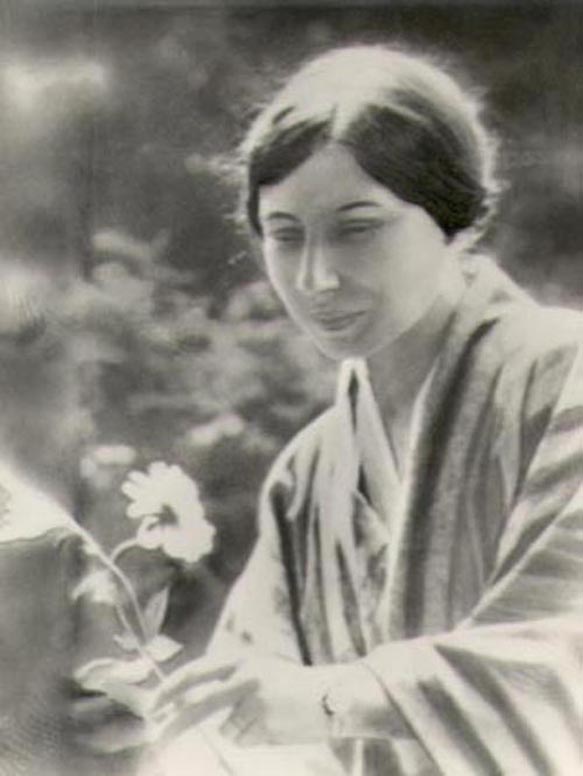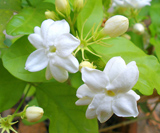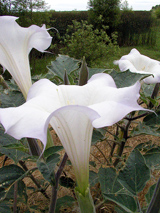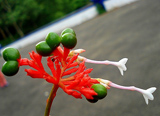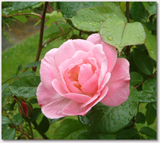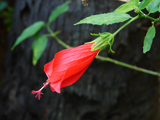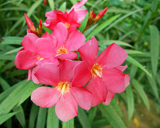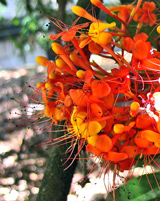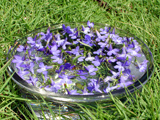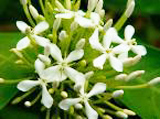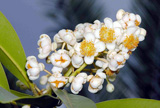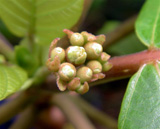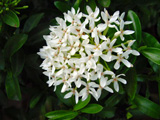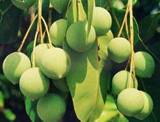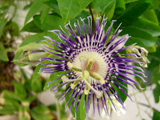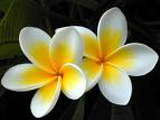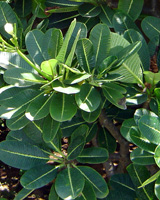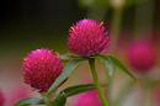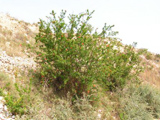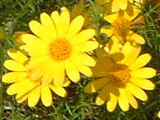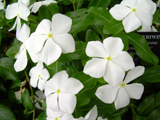Flower remedies based on the significances given to flowers by the Mother
Editor’s note
Flowers are a unique creation of Nature, for in their essential quality they represent the ‘psychic vibration in the plant kingdom’. Each of these beautiful gifts of Nature holds and manifests an aspect and power of truth. It is little wonder then that the awakened consciousness of man has been charmed by flowers and used them for therapeutic purposes. Is the renewed interest in flowers a sign of a ‘new age’ with greater sensitivities and sensibilities? Is it the sign of a growing inner receptivity of mankind which is perhaps becoming more responsible towards the earth? Somewhere within us lies the key to a rediscovery of the ‘science of flowers’ and their manifold gifts to earth and humanity.Introduction
Flowers bring a touch of beauty and joy lifting us beyond the sorrows and cares of daily life. In some countries like India certain special flowers are used to worship a particular deity. For example, the red Hibiscus is offered to Kaalii, the Dhatuuraa or Angel’s trumpet to Lord Shiva, the flower of Mudaar or Crown Plant to Hanumaan, etc. It is interesting to know that the Mother even before being acquainted with this Indian tradition, gave significances in consonance with this.Kaalii is the goddess of strength — the hibiscus has been given the significance of ‘Power’; Shiva is the eternal ascetic — Dhatuuraa signifies ‘Tapasyaa’; Hanumaan is the courageous and devoted servitor of the Lord – Mudaar signifies ‘Courage’(1).
The bright orange flowers of Saraca Indica, called Ashoka in Sanskrit literally means ‘Absence of Grief ’; which is what it vibrates to according to some flowers with which all of us are familiar. Touched by the Mother’s insight they reveal their inner depth. Jasmine is ‘Purity’; Chrysanthemum is ‘Life Energy’; Bougainvillea is ‘Protection’, and Marigold ‘Plasticity’(2).
In fact on all occasions in life; birth, death, anniversaries, and illnesses, flowers bring the freshness of nature and her happy laughter to us. And now through their remedies – the flower remedies.
Medicines have been prepared with flowers since ancient times. In Ayurveda there was a whole treatise on ‘Pushpa-ayurveda’ which has unfortunately been lost(3). In the West, flowers are used for therapeutic purposes chiefly in two ways: one for their fragrance, called Aromatherapy which utilises the essential oils extracted from flowers; the other developed by Edward Bach, called flower remedies which uses the essence of the flower in water.
Bach made and used 38 flower remedies from flowers in the British countryside. But now people all over the world are preparing remedies from indigenous flowers. So there are the Australian Bush essences, American flower remedies and the Indian Aditi-Himalayan flower remedies. The people working with these essences have been pioneers in their work and have mostly been intuitively guided to their use.
Basically there can be no systematisation of these remedies in mental terms of understanding. As Bach put it,
“They are able, like beautiful music or any glorious uplifting thing which gives us inspiration, to raise our very natures, and bring us nearer to our souls and by that very act to bring us peace and relieve our sufferings. They cure, not by attacking the disease, but by flooding our bodies with the beautiful vibrations of our Higher Nature, in the presence of which, disease melts away as snow in the sunshine.
There is no true healing unless there is a change in outlook, peace of mind, and inner happiness(4).”
Flower remedies — a therapeutic modality
The scientific world of today is shaped by certain assumptions. So anything therapeutic is also expected to fit into a set pattern. The most common assumption is that –“...there is only one sort of stuff, namely matter – the physical stuff of physics, chemistry, and physiology – and the mind is somehow nothing but a physical phenomenon(5).”
Thus we have a whole pharmacopoeia of drugs, their pharmacokinetics and pharmacodynamics. Active ingredients from gross natural products are extracted and utilised very effectively. However modern pharmacologists themselves took the cue from herbs used in ancient systems of medicine e.g. ‘Sarpagandhaa’ or ‘Rauwolfia serpentina’ was used in Ayurveda for a long time before being utilised as ‘reserpine’ by Woodward in the 1950’s(6).
The question arises, how did the early Ayurvedic physicians know of the latent qualities of Rauwolfia serpentina as an antipsychotic without any scientific background and testing? The answer perhaps lies in the fact that ancient physicians were aware that matter is not the sole reality. They, through an inner sense or consciousness could approach animate or inanimate objects and intuitively grasp their essential qualities. As put by Dr. Wills Harman in his book, Global Mind Change,
“Ultimately the reality behind the phenomenal world is contacted, not through the physical senses, but through deep intuition. Consciousness is not the end product of material evolution; rather, consciousness was here first!(7)”
The intuitive approach in the modern age has however some limitations:
1. The intuition received may be a partial truth, not the whole.
2. It has to be expressed through the mind which often distorts it by its inherent incapacity to perceive wholes.
3. It is not available on demand.
Despite these limitations flower remedies have been started and developed since the 1870’s through this approach. Edward Bach left his lucrative medical practice to discover these flower essences in the British countryside. Others all over the world have been using this approach to come in contact with the indigenous plants and use their flowers for healing.
How significances were given by the Mother to flowers
The basic difficulty in a de novo usage of flowers for remedies is the identification and understanding of what the flower represents. The Mother in a comprehensive manner explains how one can understand its significance:“By entering into contact with the nature of the flower, its inner truth; then one knows what it represents....
There is a mental projection when one gives a precise meaning to a flower. It may answer, vibrate to the touch of this projection, accept the meaning, but a flower has no equivalent of the mental consciousness. In the vegetable kingdom there is a beginning of the psychic, but there is no beginning of the mental consciousness. In animals it is different; mental life begins to form and for them things have a meaning. But in flowers it is rather like the movement of a little baby – it is neither a sensation nor a feeling, but something of both; it is a spontaneous movement, a very special vibration. So, if one is in contact with it, if one feels it, one gets an impression which may be translated by a thought. That is how I have given a meaning to flowers and plants – there is a kind of identification with the vibration, a perception of the quality it represents and, little by little, through a kind of approximation (sometimes this comes suddenly, occasionally it takes time), there is a coming together of these vibrations (which are of a vital-emotional order) and the vibration of the mental thought, and if there is a sufficient harmony, one has a direct perception of what the plant may signify(8).”
Thus she identified the white flowers of Ixora thwaitesii as ‘Peace in the cells’; the pink country rose as ‘Surrender’; the paper flowers with a globular head, Gomphrena globosa, as ‘Immortality’ etc. The colours too symbolise the nature of their aspiration.
The incisive psychological understanding of the different planes of consciousness and parts of the being, from Sri Aurobindo is evident here. The editors of the book, Flowers and their messages, state,
“When we study the messages given by the Mother to flowers we find that certain colours correspond to certain planes of consciousness, certain levels of the being(9).”
Yellow is the colour of mental aspiration (there are of course exceptions, shades of blue can also indicate the mind); light pink is the colour of the psychic region; red is the colour of the physical; the higher vital is lavender, deep mauve or deep carmine and the vital proper is blue or dark red.
But colour alone does not determine the significances. The shape and size of the flower, the quality and intensity of its fragrance, even the time and manner of blossoming is important. The characteristic feature and trait of the plant is expressed through this significance(10).
How did we correlate the significance of flowers to problems in health and illness
From the evolutionary perspective we see the progress of consciousness from matter through life and mind, still retaining its links in all life forms. So man is not separated from the world around him but is part of the whole and is being influenced by the whole.
According to the Yogic perspective too,
“What difference is there between the human body and the body of the tree? In truth, there is none: the consciousness which animates them is identically the same(11).”
Thus viewing health and illness from the consciousness perspective we began correlating the vibrations and patterns of flowers to human problems and disease.
We started with flowers like ‘Peace in the Cells’ (Ixora thwaitesii) and ‘Peace in the Nerves’(Guettarda speciosa) which were simple to understand and use as remedies. For disorders of sleep, tension, anxiety and stress, they worked well. This gave us the inspiration to explore ‘Integral Immortality’(Gomphrena globosa), ‘Mental Simplicity’ (Thymophylla tenuiloba) and ‘Divine Solicitude’(Malvaviscus arboreous) etc. A pilot study among ourselves and our patients showed many interesting facets of the remedies. A person who had been suffering from angina took ‘Divine Solicitude’. At night he saw the peacock feather of Sri Krishna caressing his heart and clearing up his blockages. That night he was able to sleep without drugs(12). This showed us that given at the right moment, these remedies evoke deeper unexpected psychological responses. These responses may not be replicated but are subjectively curative. An 11-year-old girl was referred for an atypical substance abuse — glue and petrol sniffing (a serious condition that can cause brain damage). She improved dramatically with ‘Turning Wrong Movements to Right’ (Nerium oleander – Magenta or deep red). Many subjects with common cold responded very well to ‘Mental Simplicity’.
All these initial experiments led us to a wider therapeutic use of flower remedies. Praying for the Mother’s guidance, we intuitively worked them out. We also used aids like detailed interaction, changes in the pulse, changes in the aura and sensing the inner causes of disequilibrium. We attempted to cross-match our selections with guidance from the Tarot cards. Depending on the person needing the remedy and the feeling of the therapist, one or the other aid was chosen to strengthen the intuitive perception.
It was necessary not only to choose the correct remedy but also to choose the correct timing of the prescription.
(a) Interaction
By talking with the person about his or her life, its difficulties and joys, clear patterns emerged which led to the selection of a particular remedy. The symptoms were explored. This was interesting as the same symptom in different people often had a different story to tell.Dreams were also used as they expressed many things the person was not conscious of.
Through a series of talks the person himself or herself could sometimes understand the flower remedy needed.
Different remedies are needed at different times of our life depending on the difficulty one is facing at that time. This difficulty may present itself as an illness, discomfort, unease or strong emotion.
A recognition of the disorder aids in the selection of the right remedy. The main task of the person giving and receiving the remedy is to discover this inner disharmony i.e. to discover the factors which take us away from the soul — its happiness, wideness, love, joy, trust etc., creating a sense of disease. The flower chosen should vibrate to the inherent soul vibration of the individual, thus correcting the discordant notes.
A few questions which can help in this selection are:
* What is causing this discomfort or suffering in my life?
* What do I really want, so that my life will be fulfilled and happy?
* What are the things within me that prevent my fulfillment?
The possibility of choosing the correct flower, increases to the extent that one can match the vibration of the flower remedy to the person who needs it.
This is a complex work of study, experience and an inner development. But once the flower selected is right and is given at the right moment, the action may be instantaneous. As a person having a headache reported after ‘Peace in the Nerves’, “It was a miracle.”
(b) Pulse method and changes in the aura
When there was a doubt and no clear remedy emerging i.e. the inner sense was not clear enough; the pulse method or scanning of the aura was used.The pulse method is used by many therapists all over the world. In the Unani and Tibetan systems of medicine it is highly developed for diagnosis. What we observed was that the character of the pulse changed when the correct remedy was placed in the patient’s hand; other remedies had no effect.
The scanning of chakras before and after the remedy was in the person’s aura showed whether the remedy would work. If the deeply affected chakras cleared up the remedy chosen was correct.
But both these methods are more laborious and time consuming as compared to the intuitive way. So they have been less frequently used.
(c) Tarot cards
These are symbolic cards used by alchemists who were Occidental esoterics of the Middle Ages. These cards were used for understanding man, ‘the sacred stone’hidden within, the Universe and God.The symbolism revealed by the selected Tarot cards gave meaningful interpretation of flower remedies and in some cases helped in the selection of the correct remedy.
How the remedies are prepared
The flower remedies of SAIIIHR (Sri Aurobindo International Institute for Integral Health and Research) are prepared from flowers whose significances were given by the Mother. They are prepared just as simply as the flowers themselves by keeping them in a bowl of Ganges water in the sun for 1 1/2 hr. The water is then charged with the essence of the flower. The selection of the flowers, tuning in to the plants and nature and the preparation of the remedy are all clear, uncomplicated wholes. A peace, joy and limpidity pervades the scene. The flowers too, when they are taken out of the water are surprisingly fresher than when they were plucked. They are then returned to the soil.The water is bottled and kept in the Mother’s room for some time.
“Look at the flowers and trees. When the sun sets and all becomes silent, sit down for a moment and put yourself into communion with Nature: you will feel rising from the earth, from below the roots of the trees and mounting upward and coursing through their fibres up to the highest outstretching branches, the aspiration of an intense love and longing, – a longing for something that brings light and gives happiness...
There is a yearning so pure and intense that if you can feel the movement in the trees, your own being too will go up in an ardent prayer for the peace and light and love that are unmanifested here(13).”
To receive the full benefit of flower remedies one must be receptive. The remedy then through its gentle, soft and deep action unfolds itself bringing harmony where there was a disorder. But even if apparently there is a lack of trust, the remedy still acts, though one can attribute this action to other things.
What happens when you take the flower remedy?
Taking the remedy is an experiential phenomenon. In the case of a physical disorder one can note down the symptoms that have changed after giving the drug, but in the case of a flower remedy there is that ‘good feeling’ or ‘quietness’ or a ‘soft gentle soothing effect’. There are those simple everyday irritations and lethargy which we had taken for normal and natural which just disappear leaving us fresher and more energetic. The ability to make correct choices in life, the seemingly simple, normal maturity which is never noticed, may be the effect of the flower remedy. The physical symptoms are also relieved. There is a feeling of freshness and life just like the flower itself. In fact, many times one just allows the blossoming to happen after one dose of the flower remedy. Like the ripples that spread in a pond, everything is stirred, all the levels touched and changed — so gently that one didn’t even notice it.To perceive the action of the flower remedy instantaneously one should be very quiet, still and receptive while taking it. The mouth should be clean.
The remedies themselves should be placed in a clear pure environment, e.g. puujaa room or meditation area.
Flower remedies from SAIIIHR
The flower remedies from SAIIIHR differ from those around the world in:
1. They are consecrated to the Divine.
2. They are made from flowers whose significances have been given by the Mother.
3. The flowers are kept in the sun for one and half hour (not three hours as prescribed by Bach flower therapists); the sun in South India being much stronger.
4. We do not use the boiling method for preparing the remedies.
5. Instead of brandy we use Ganges water for preservation which is specially gathered from its Himalayan source. This we found to be a better preservative than brandy.
6. The flowers we use are those grown in the Ashram gardens.
7. The flowers remain fresh instead of showing signs of fading after the preparation of the essence.
Individual remedies
The following information has been derived from Tarot cards and the patterns that emerged after practical experiences with people.Nine remedies have been extensively worked upon as follows.
1. Peace in the cells
(Ixora thwaitesii — white)
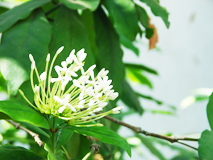
“The indispensable condition for the body’s progress(14).”
Ixora thwaitesii like other Ixoras is an umbel-shaped inflorescence of white star-like flowers with a strong fragrance. Its buds are curled up amidst the blossoming flowers and point beyond the inflorescence as if invoking peace.
Theme of the remedy
It brings peace, balance, quietness, harmony and freedom in the body and nerves. The agitations due to suppressed emotions, secret fantasies, sexuality, are brought to light. Persistent psychological patterns in families causing disturbances are harmonised. The person grows up and can now detach from the parents. One is often faced with questions about the real identity and purpose in life. A freedom from attachments and guilt ensues. A new identity emerges.The dreams can be nightmares with this remedy but one wakes up quiet and peaceful.
A middle aged lady had sleep problems since her childhood. She had been taking diazepam (calmpose) for two years, every night. There was anger and resentment against people and situations, impatience and attacks of panic. After a single dose of ‘Peace in the cells’ and ‘Silence’ she said, “I had a beautiful experience. The mind which was completely restless, anxious and chaotic became silent, quiet and still. Now I can sleep four to six hours at a stretch. I get a deep sleep after lunch also which has never happened before.”
This remedy works well in combination with ‘Peace in the nerves’, ‘Peace in the physical’ or ‘Silence’.
2. Peace in the physical
Calophyllum inophyllum (Alexandrian Laurel, Indian Laurel)
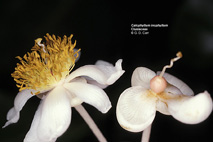
“To want what God wills is its best condition(15).”
The Indian Laurel is a medium sized, strong tree with thick oval-shaped leaves. The flowers grow as branching racemes. They are delicate white single rotate flowers with numerous yellow stamens and a strong fragrance.
Theme of the remedy
This is a strong remedy which balances the physical, vital and mental levels and centres them around the psychic.1 Peace, quietness and harmony result after a tempest. Everything is shaken up.Though a strong flower remedy, it creates softness, gentleness, peace and harmony within. It brings a quiet joy, peace and balance. The individual loses his illusions of personal pride and power. He can now find the light and love within.
One feels bathed in peace.
The sleep is very good with this remedy. Dreams revealing one’s real identity emerge. One can hear the call for inner harmony and unity. One can choose the work which is in harmony with one’s true nature.
This remedy opens one to higher things – one can now choose to become an instrument of the Divine.
1 Psychic is the spark of the Divine in the individual which develops through lifetimes.
3. Peace in the nerves
(Guettarda speciosa)
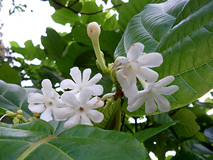
“Indispensable for good health (16).”
Guettarda speciosa is a tall delicate tree which blossoms from December to March. The flowers are in cymes, tubular, white and delicate.
They bloom only at night and the fragrance spreads far and wide.
(The remedy from this flower was made on a fullmoon night. It was sparklingly clear and highly fragrant).
Theme of the remedy
People needing this remedy instinctively know their inner truth or that they want something more from life or that they need to change but cannot do so. They are too much involved in the struggles of life creating nervousness and tensions.This remedy if given at the right moment calms and clears the emotions bringing a sudden clarity, peace and order. Long standing problems are resolved in that instant. One opens to the beauty of one’s deeper self – the Divine source — like a bud opening to the sun. The effect is short and quick. Other remedies may be needed as a complement or follow up.
Emotional conflicts are cleared up and doubts about past relationships surface. Sexuality is not fantasised about but becomes clear and open. Thus there is mental clarity and relief of physical disorders. The physical consciousness itself connects to its Divine source.
A new cycle and a new life begins with this remedy bringing fresh energy.
The dreams however can be very chaotic as old problems are relived in a new light. There is an intense inner work in sleep but the person wakes up fresh.
The three remedies; ‘Peace in the cells’, ‘Peace in the physical’ and ‘Peace in the nerves’, are mostly used together when peace needs to be felt not only at the psychological but also at the physical level. Together they produce a stability in the system with a feeling that one can bear anything. Repetitive obsessive thoughts seem to become very prominent in some people, in which case the addition of ‘Silence’ is helpful.We found that in some subjects, subsequent remedies had to be added after an initial stabilisation through ‘Peace in the cells’, ‘Peace in the physical’ and ‘Peace in the nerves’.
In some of our cases the output of urine increased.
Ailments helped
This combination has been helpful in cases of eczema, alcoholism, arthritis, spondylitis, anticipatory anxieties, headache, migraine, tension at work, sleep problems, flatulence, asthma, fever, recurrent colds and coughs when due to stress, essential hypertension, angina, epigastric pain, irritable bowel syndrome and hypochondriasis.Demonstrative cases
(1) This person was undergoing great upheaval in her life. She was under emotional, physical and mental stress as she was caring for two adults at home and also working in the office. Besides, her husband was wanting to divorce her. She had a nervous breakdown and was unable to sleep. Tranquilizers helped but she felt heavy and lethargic the next morning. After taking a combination of ‘Peace in the cells’, ‘Peace in the physical’ and ‘Peace in the nerves’ for 7 days, she reported:“The quality of sleep is very different now. I feel uplifted in the morning. There is a deep sense of quietness. The sleep is now deep and refreshing. Things still happen in the outside environment but do not touch me any more. I do not feel things with the same intensity. Am I becoming hard? However I am not upset. I wait and I do not get so involved with others anymore.”
(2) This 52-year-old teacher, living in a joint family was suffering from sinusitis, asthma during winters, gas problems, skin rashes and headache ever since her marriage. She had taken homoeopathy with some relief. She used these remedies locally for headache.
“I was having headache so I applied the flower remedy to the painful spot. After lunch, on going to bed, I felt a great turmoil in the head which subsided after some time. I then slept deeply. I now feel good, even the constipation has subsided. There has been no asthmatic attack but I have to wait and see.”
4. Silence
(Passiflora incarnata; Kaurava-Paadoava)
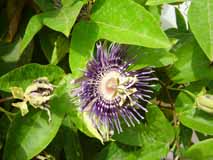
“The ideal condition for progress(17).”
This is a heavy creeper with trilobate leaves. The flowers look like a clock. The outer multiple petals are purple and white in bands. Inside are 5 stamens and one pistil. The flowers start opening from 8-10 a.m. as the sun rises and close when the sun sets in the evening. The fragrance is strong and cleansing. In India, this flower is called ‘Kaurava-Paakoava’ after the famous brothers of Mahaabhaarata: the 100 Kauravas (outer manifold petals) surrounding the 5 Paakoavas (the 5 stamens) at whose centre stands the Divine, Krika (the one pistil split into 3) with the triune powers. In fact the remedy seems to reflect this story symbolically.
Theme of the remedy
This remedy is suited for people who are caught in the battle of life. Despite their character and strength they are forced to fight. Doubts, conflicts and turmoils rage within them. They develop migraines with incessant thoughts, colics etc. They cannot act and are immobilised till ‘Silence’ brings forth the deep inner quietness of the divine within giving sense to everything. All becomes quiet and free. Like Krishna speaking to Arjuna, life and action fall into place. Old ideas and ideals are broken. There is turmoil and destruction on the mental level — yet ‘Silence’ reigns within. One is born to another way of life and action. The dreams are turbulent, speaking about emotional issues and a childhood where nobody listened to you or understood you.This flower brings a deep quietness. Mental preoccupations are silenced and there is freedom within.
Such is the case of this young girl with psoriasis who was brought up in a joint family. The male members were busy with their business. She was close to her mother who was too attached to her. She talked a lot as a child but felt that nobody really understood her. She was a perfectionist with high ideals. Faced with competitive exams where the other students were equally good if not better than her, she developed psoriasis, sleep problems and a weak memory. During this period she kept coming to Pondicherry to seek solace even though it meant travelling thousands of kilometers.
Four months after taking ‘Silence’ she reported,
“Immediately after the remedy I started feeling happier and more relaxed. I finished my exams well. The psoriasis is almost gone. My sleep became good and refreshing.”
Ailments helped
• Migraines
• Sleep problems
• Dysmenorrhoea
• Premenstrual tensions
• Psoriasis
• Sinusitis
5. Psychological Perfection
(Plumeria rubra; Champa, Frangipani, Pagoda tree, Temple tree)
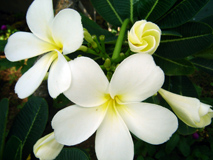
“There is not one psychological perfection but five. They are sincerity, faith, devotion, aspiration and surrender(18).”
This is a small tree with friable branches. At the tips of the branches sprout these very fragrant waxy flowers arranged in clusters. Each flower has five petals which together turn clockwise. They are white with a prominent yellow centre or light yellow with a white border.
Theme of the remedy
This is a deep yet simple and clear remedy going back to the origin of things – to unity, to the soul within. The first quality according to the Mother is sincerity. She says,“For if there is no sincerity, one cannot advance even by half a step... But it is possible to translate it by another word, if you prefer it, which would be `transparency’. I shall explain this word: Someone is in front of me and I am looking at him; I look into his eyes. And if this person is sincere or `transparent’, through his eyes I go down and I see his soul — clearly(19).”
So the remedy in a very simple way helps one to connect to one’s soul. But the problems of the ego can surface and raise obstacles. To overcome them one must have trust or faith in the Divine. As she says,
“Those who have what they call an unshakable faith in the Divine, and say, `It is the Divine who is doing everything, who can do everything; all that happens in me, in others, everywhere, is the work of the Divine and the Divine alone’, if they follow this with some kind of logic, after some time they will blame the Divine for all the most terrible wrongs which take place in the world and make of Him a real demon, cruel and frightful – if they have no trust.
Or again, they do have faith, but tell themselves, ‘Well, I have faith in the Divine, but this world, I see quite well what it’s like! First of all, I suffer so much, don’t I? I am very unhappy, far more unhappy than all my neighbours’ – for one is always far more unhappy than all one’s neighbours – ‘I am very unhappy and, truly, life is cruel to me. But then the Divine is divine. He is All-Goodness, All-Generosity, All-Harmony, so how is it that I am so unhappy? He must be powerless; otherwise being so good how could He let me suffer so much?’
That is the second stumbling-block.
And the third: there are people who have what may be called a warped and excessive modesty or humility and who tell themselves, ‘Surely the Divine has thrown me out. I am good for nothing, He can do nothing with me, the only thing for me is to give up the game, for He finds me unworthy of Him!(20)”
Depending on the circumstances and need of the people this flower remedy brings an understanding and deeper faith. It helps to overcome the little egoistic outlook of life and the universe.
“One hears a bird sing, sees a lovely flower, looks at a little child, observes an act of generosity, reads a beautiful sentence, looks at the setting sun, no matter what, suddenly this comes upon you, this kind of emotion — indeed so deep, so intense – that the world manifests the Divine, that there is something behind the world which is the Divine(21).”
This is the feeling of devotion and gratitude.With this remedy it seems that disorders are offered to the highest source — the Divine with devotion and gratitude.
There arises the possibility of connecting all the past problems, the inherited disorders, deep inconscient things, obscurity, problems from past lives, genetic diseases etc. to the Divine in an ‘aspiration’.
“And this taste for Supreme adventure is aspiration – an aspiration which takes hold of you completely and flings you, without calculation and without reserve and without a possibility of withdrawal, into the great adventure of the divine discovery, the great adventure of the divine meeting, the yet greater adventure of the divine Realisation; you throw yourself into the adventure without looking back and without asking for a single minute, `What’s going to happen?’ For if you ask what is going to happen, you never start, you always remain stuck there, rooted to the spot, afraid to lose something, to lose your balance(22).”
‘Psychological Perfection’ opened something like this in a young air hostess who was afraid of closed spaces and flying and restored her self-confidence.
It has cured obsessions, suspicions, nightmares and fears from deep secrets. Like the other remedies it helps one to detach from the problems and remain quiet.
The dreams are chaotic. All the injustice you are faced with or have committed rises to the surface.
The possibility of offering the psychological problems to one’s soul and the Divine in a very simple way now becomes possible. This remedy helps one to grow up and follow one’s inner call.
Ailments helped:
• Anxiety neuroses• Claustrophobia
• Behavioural disorders in the mentally handicapped
• Alcoholism
• Sinusitis
• Cervical spondylosis
6. Integral Immortality
(Gomphrena Globosa — white;
Globe amaranth)
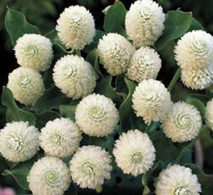
“Immortality is not the survival of the mental personality after death, though that also is true, but the waking possession of the unborn and deathless Self of which the body is only an instrument and a shadow.”(23)
“Immortality – Forms are in perpetual transformation; identify yourself with the Immortal Consciousness and you will become It(24).”
“Integral Immortality – It is a promise. When will it be a material fact?(25)”
The flower of Integral Immortality is a white hard spiky flower in a rounded head-like inflorescence. These flowers last for a long time (the seeds are merrily savoured by the squirrels of Pondicherry).
Theme of the remedy
This is a remedy that changes things which were ‘stuck’. There is an opening of the consciousness to infinity and eternity. The difficulties are rapidly discovered and cleared. It is almost like a ‘grace’.One should however take this opportunity to begin a new way and not go back to the old patterns. For it works on the past, the inconscient, the ‘deep hidden diseases eating you from within’. In a quiet way it creates a movement in the depths helping to open to Light.This is one remedy that works drastically and makes it clear that it was not by one’s own efforts alone that one was cured. This was experienced by a person who had mouth ulcers off and on since childhood and was experimenting with the flower remedies without much faith. There seemed to be some effects with other remedies but the skeptic in her was not satisfied. After 4 drops of ‘Integral Immortality’ her mouth ulcers which had been present for the past 15 days disappeared. It could not have been anything else. And so instantaneously! It was like a miracle.
But now one must reflect within and deeply understand the new consciousness that begins to grow. It helps one to detach from the environment and follow the inner call.
It may help in easing the process of death also. This was an elderly man who suddenly developed severe chest pain (? a heart attack). He had had two heart attacks in the past where the pain had persisted for three to four days, had developed ventricular arrythmias and had become very restless since then. His son, a homoeopath, using flower remedies with the Mother’s significances, gave him ‘Integral Immortality’. As he sipped it, he became very quiet and still. The pain subsided. He called his son, thanked him and departed peacefully.
This remedy connects the physical consciousness to the Divine. A lot of upheavals ensue bringing great changes in life. The dreams explain these changes and one can understand the reasons of one’s illness now. The nights are rejuvenating.
The being can turn to follow the call of the Divine. A stable base is prepared for the future.
Ailments helped:
• Inherited disorders• Hyperacidity
• Fissures
• Piles
• Mouth ulcers, gingivitis
• Asthma
• Arthritic pains
• Perianal abscesses
• Cervical spondylosis
7. Divine Love
(Punica)
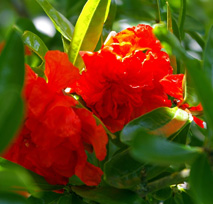
“Long ago, very long ago, in the desert land that is now Arabia, a divine being incarnated on earth to awaken it to the Supreme Love. As one would expect, he was persecuted by men, misunderstood, suspected, hunted after. Mortally wounded by his assailants, he wished to die alone, quietly, so that his work might be accomplished; and, pursued by them, he fled. Suddenly in the broad barren plain, a tiny bush of pomegranate appeared. The Saviour stole under its low branches in order to give up his body in peace; and at once the bush expanded miraculously, increased itself, widened, became deep and luxuriant in such a way that when the pursuers passed by they did not even suspect that the One whom they were chasing was hidden there, and they continued on their way.
While, drop by drop, the sacred blood fell, fertilising the soil, the bush covered itself with marvellous flowers, scarlet, enormous – clusters of petals, innumerable drops of blood....
These are the flowers that, for us, express and hold the Divine Love(26).”
This is the flower of a type of pomegranate tree. The petals of this flower are innumerable and crinkled, a brilliant vermilion colour. They seem to be always ready to fly to anyone who wants them. The calyx is however hard and strong, trying as if to hold these innumerable soft petals together. Even when dried these petals retain their colour and freshness.
Theme of the remedy
A remedy with a deep force, intensity and warmth; full of joy and love. It connects one to the Truth removing all that is unreal. The difference between vital and psychic love is disclosed. The simplicity and sense in life which was forgotten is now rediscovered, deep within, in silence. There is a struggle between human desires, attachments and impurities and the quiet, gentle, simple love and trust within. People needing this remedy are closed in on themselves, lonely and asking for help. They are caught by their past unhappiness and childhood’s lack of love. This remedy in a simple, direct, powerful way clears this and acts concretely. A deep joy ensues.This was revealed by a middle-aged man who had been habitually constipated since childhood. His mother had died when he was small and the siblings were looked after by him. He got no love from his stepmother either. His wife, who was trying these flower remedies reports:
“I put one drop of `Divine Love’ on his tongue. After this drop he felt a great upheaval in the stomach with acidity and gas --— as if the food was coming out. In 4-5 hours he passed stool 4 or 5 times and felt very light.
His eczema also improved. The constipation has decreased. He refuses to take Divine Love again.”
He has also now changed his profession and become a healer. There was a quiet radiant joy on his face when I met him last.
Such can be the action of these remedies!
Ailments helped:
• Menopausal problems• Eczema
• Recurrent joint pains
• Sleep disorders
• Constipation
8. Mental Simplicity
(Thymophylla tenuiloba; Dahlberg daisy; Hymenatherum)
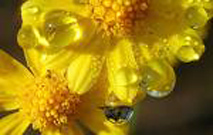
“I have always found that this one (Mental Simplicity) has a cleansing fragrance; when you breathe it, ah, everything becomes clean — it’s wonderful! Once I cured myself of the onset of a cold with it – this can be done when you catch it at the very beginning. It fills you completely, the nose, the throat(27).”
“Does not like complications(28).”
This is a small perennial plant used in gardens as a seasonal ground cover. Small bright yellow compositae flowers are set among finely frilled aromatic leaves. The flower heads are perched on delicate long stalks which sway laughing in the breeze. A very inconspicuous yet powerfully attractive flower.
Theme of the remedy
This is a strong flower remedy which clears and makes transparent the mental will. A great clarity and simplicity in the mind ensues so that the body can instinctively bring order in itself. As She says,
“As soon as all effort disappears from a manifestation, it becomes very simple, with the simplicity of a flower opening, manifesting its beauty and spreading its fragrance without clamour or vehement gesture. And in this simplicity lies the greatest power, the power which is least mixed and least gives rise to harmful reactions....
Simplicity, simplicity! How sweet is the purity of Thy presence!(29)”
Thus it brings great changes in life patterns. Disease becomes a passage and opening to new things. Doubts are cleared and can be expressed. Old ideas and mental willings can be left behind. A simple trust emerges in harmony with the new way one must now choose.
It works on the body, mind and vital in a very simple way. It brings lightness and simplicity on all the levels. The dreams show a great mental activity and destruction. Questions of Why? What? How? are raised. Fixed ideas are replaced by fresh answers which are strong and clear. A new cycle begins. The sense of life and true vocation is revealed so that the family patterns can be left behind. One can now take decisions in harmony with one’s real personality as the mind, emotions and body are in harmony.
A soft, tender rebirth.
Ailments helped:
• Fixed ideas
• Headaches
• Colds
9. Integral Progress
(Catharanthus — white; Sadabahar, Muda- gascar Periwinkle)
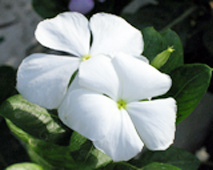
“Progress — the reason why we are on earth(30).”
“Integral progress – Cannot be satisfied except by integrality, it is the best way of progressing quickly(31).”
This is a perennial plant growing in the wild, in any nook and cranny, in the toughest conditions. The plant has been used in Ayurveda for many medicinal preparations especially for diabetes and cancer. Recently it has been used for extracting the anti-cancer drug ‘Vincristine’. Its flowers are very simple and strong, star-like, with rounded petals and a narrow corolla. The buds are curled clockwise and make an interesting combination.
Theme of the remedy
This is a simple flower remedy questioning one’s potentials, habits, desires and ways of being. A new knowledge emerges. There is perfection behind its simplicity. It helps to understand the past sufferings and failures and one can now grow out of them. In a clear dynamic way it brings a new turn in life, a change, a progress. The childhood fears surface and problems of being recognised arise. But one understands that one cannot look for the sense of one’s life in other’s eyes.
A person needing this remedy has strong vital traits with an unwillingness to change. There is a great stress and nervousness due to too much mentalising. Sexual obsessions may also be seen.
The remedy clears old patterns so that one can now open to something new and vast – if the person listens and is ready.
The dreams are soft, loving and sweet. They speak of beauty, love and choices in life in a very gentle way. Understanding dawns as if one contemplates on the patterns of one’s life. Emotions are purified. One may feel weak and helpless during the transition but a new life begins. The body is rejuvenated; the vital is shaken up and understands its mistakes, it can now clear up and consolidate its strength; the mind is forced to give up its narrowness and emerge into the vastness of reality. It helps one to reconnect to the Divine.
Ailments helped:
• Sudden grief
• Impaired mental development
• Epilepsy in a mentally retarded child
• Adolescent psychological conflicts
• Diabetes mellitus
Conclusion
Healing is a complex process which includes many things: the faith of the person, his or her receptivity, the stage of development etc.The ultimate healer is within each one of us. Flower Remedies are only aids for its discovery. They are not a panacea.
The work is still in its inception. The findings need to be replicated in a larger number of subjects at different places and monitored over long periods of time.
Acknowledgments
—Kiran and Julia for the flowers.—Francoise for the Tarot readings.
—Sheila and Sushma Khandelwal for all the paper work.
—Dr. S. Ramanujam, Dr. S.R.Ramaswamy and Dr. Soumitra Basu for case studies.
—Madhunandini for the flower drawings
References
1. Vijay (Ed.). Flowers: their Spiritual Significance. Pondicherry; Sri Aurobindo Society, 1988, p. 10.2. Ibid., p.14.
3. Sharma, P.V. Pushpaayurvedah. Varanasi; Chaukhambha Visvabharati, 1997, preface.
4. Scheffer, Mechtild. Bach Flower Therapy-- theory and practice. New Delhi; B. Jain Publishers, 1991, p. 13.
5. Dennet, Daniel C. Consciousness Explained. Boston; Little, Brown and Company, 1991, p. 33.
6. Goodman Gilman, A.; Rall Theodore W.; Nies, Alan S. and Taylor Palmer. The Pharmacological Basis of Therapeutics. Republic of Singapore; Pergamon Press, Inc., 1991, p. 386.
7. Brennan, Barbara Ann. Light Emerging. USA; Bantam Books, 1993, pp. 31-2.
8. The Mother. Flowers and their Messages. Pondicherry; Sri Aurobindo Ashram, 1995, p. XI.
9. Ibid., p. 258.
10. Ibid., pp. 258-9.
11. Ibid. An Experience.
12. Gupta, V. Use of Flower Remedies— a personal experience. NAMAH 1996; [4(1)]: 87-89.
13. Op.Cit. Flowers and their Messages. p. I.
14. Ibid., p. 143.
15. Ibid., p. 44.
16. Ibid., p. 109.
17. Ibid., p. 187.
18. Ibid. p. 196.
19. Op. Cit. Flowers: their Spiritual Significance. p. 22.
20. Ibid., pp. 22-4.
21. Ibid., p. 25.
22. Ibid., p. 26.
23. Op. Cit. Flowers and their Messages. p. 108.
24. Ibid.
25. Ibid.
26. Ibid., p. 204.
27. Ibid., p. 238.
28. Ibid.
29. Op. Cit. Flowers: their Spiritual Significances. p. 34.
30. Op. Cit. Flowers and their Messages. p. 52.
31. Ibid.
Dr. Vandana has been working in SAIIIHR on flower remedies for the last 18 years.
Share with us (Comments, contributions, opinions)
When reproducing this feature, please credit NAMAH, and give the byline. Please send us cuttings.
